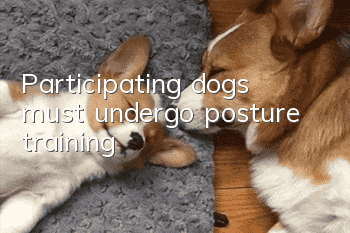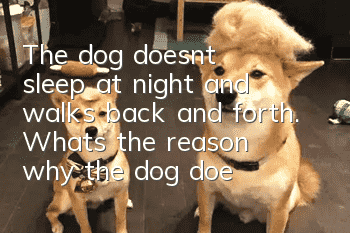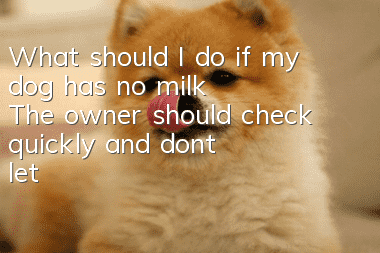Participating dogs must undergo posture training

Pet.com learned that during the competition, in addition to observing whether the dog's appearance is beautiful, the quality of its standing posture is also the key to winning. Therefore, it is necessary to train the dog to assume a good posture.
Standing position: Taking advantage of the dog's fear of falling, perform it in a small area and above the ground. You can use a small table or a raised wooden board. First, hold the dog on the small table, let its hind legs close to the edge of the small table, and let go of the hand. The dog is afraid of falling, so its limbs become weak and wants to lie down. At this time, I need to hold its chest or chest with one hand. chin, and the other hand gently pulls the dog's tail back. Be careful not to pull only the tail hair, so as not to cause pain. The hand holding the chest also pushes back to prevent the dog from sitting down. When the dog realizes that its hind feet will lose support and will hit the ground again when it retreats, it will instinctively lean forward and straighten up, with its forelimbs firmly planted and its toes tightened, showing a standard of straight limbs and bowed chest. posture. As long as this method is repeated many times, the dog will learn that even if it is standing on flat ground, as long as I hold the tail and pull it backward, the dog will reflexively assume a standard graceful posture.
Sitting down: This is a component of training combined with other subjects. The trained dog is required to sit down quickly and correctly after hearing the command, and to persist for a certain period of time.
During training, let the dog stand on the left side of the owner. While giving the "sit" command, lift the collar with your right hand and press the dog's waist corner with your left hand. When the dog sits down voluntarily under the stimulation of this machine, it should be rewarded immediately. After repeated training many times, the dog can develop the movement of sitting down. On this basis, training is carried out in conjunction with gestures. If you are asked to sit on the front, stretch your right upper arm flat outwards, and your forearm is vertical upward, with the palm of your hand facing forward to form an "L" shape; if you are asked to sit on the left side, tap your left abdomen with your left hand. If the dog can already do the "sitting" action, it should be gradually trained to extend the sitting time, from being able to sit for 35 seconds until it is extended to more than 5 minutes.
Lying down: The action of lying down should be performed after the "sitting" action is learned. During training, two methods can be used: First, the owner is on the right side of the dog, facing the dog, holding the food in his right hand, slowly moving from the top of the dog's mouth to the bottom, and at the same time giving the lie down command, and pulling the leash downward. , give you pleasure. At this time, the dog can lie down under food and mechanical stimulation. When the dog lies down, reward it with food in time. In the future, as the conditioned reflex develops, rewards and stimulation will be gradually removed. Another method is to make the dog sit down. The owner should squat down, hold the dog's two forelimbs with both hands, stretch them forward, and press the dog's shoulder blade with his left arm. The dog will then lie down. At this time, he should be given Reward with food. In the future, the dog should be trained within a certain distance and combined with gestures (left arm drooped, palm forward, palm down, and waving up and down) to improve its level of action, extend the command distance, and be able to follow the owner's command The ability to lie down for more than 5 minutes with hand gestures.
Standing: During training, the shilling dog sits down, then gently pulls the leash, and gives the "stand" command and gesture (stretch your right arm toward the dog, palm upward). When the dog stands, reward it. The master wants to evictGradually leave the dog's side so that the dog can stand longer. On this basis, gradually develop the ability to stand and continue for a certain period of time according to gestures or commands.
Zuo Yi: performed on the basis of the "standing" movement. During training, the owner stands opposite the dog and first issues the "stand" command. When the dog stands firmly, he issues the "thank you" command. At the same time, he grabs the dog's forelimb with one hand and swings it up and down. After repeating it several times, reward it with petting and food. Then keep a distance from the dog and no longer use your hands to assist when giving commands. If the dog can't do it, repeat it a few more times until the dog can do it. At the beginning of training, you can add some simple gestures, but you must prevent the dog from conditioned reflexes to the gestures. When the movement is very stable, as long as the "thank you" command is given, the series of reflex activities of standing and bowing will be completed in one go, without the need to give the command twice.
- Dog’s anal gland odor, please note that this is a sign of your dog’s health!
- How to make your dog like to eat dog food Four ways to make your dog fall in love with dog food
- How to protect your dog’s food? Teach you tips on training your dog
- Why do dogs defecate everywhere? How can dogs stop defecating everywhere?
- What should I do if my dog has lupus? Immune system diseases should not be underestimated
- If your dog's hair is cut and the skin is cut, the flesh is exposed. If the dog's hair is accidentally cut and the skin is cut, it must be disinfected immediately.
- Do dogs need deworming in summer? What should you pay attention to when raising dogs in summer?
- What to do if your dog has indigestion? Dog indigestion is no small matter!
- What should you pay attention to when vaccinating your dog? What should you pay attention to when vaccinating your dog?
- Symptoms of Rheumatism in Dogs What conditions can cause rheumatism in dogs?



